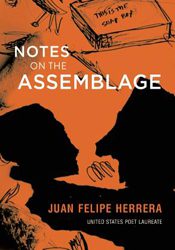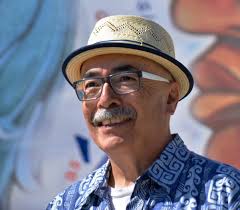
Juan Filipe Herrera is the current United States Poet Laureate and his newest collection is his thirtieth book, though not all his books are poetry. This collection, Notes on the Assemblage, has a cover that is a montage, gray, white and black with the central shapes something of a Rorshach test. In the upper right is an image of a book on which are the words “This Is the Soap Box.” This direct and effective . He has been more subtle in his earlier collections, and also just as understandably pained and angered by subjects he has long chosen and continues to choose.
His influences are wide and he wants you to know about them, in part, he often suggests, because knowledge enhances song and that message can get lost in superficial popular culture. So the book opens with two short epigraphs, one by Marvin Bell, who is respected in established poetry circles, and one by Violeta Para, a legendary Chilean folk musician who brought traditions of her country’s rural life to its cities, and whose artwork was exhibited at the Louvre.
Both examples point toward a deliberate, acute way of looking and responding, which is, of course, what Herrera participates in and what he wants the reader to join him in. He makes it manageable, without every making it seem slight or too easy. “It Can Begin With Clouds,” is the first poem in the book, and it is a fine opener :
it can begin with clouds how they fray how they enter
then how they envelope the earth
in a second or two they vanish you
touch them they take you you find yourself in their absence
sometimes you read them somehow
the separation the losses the sky yes
it is the sky they were talking about the character for sky
you are there now
you have always been there now
where there is fire and
thunder-face behind the torn universe you can see this
how its shreds itself so you can see this that
is all there is then
nothing again then you again and the clouds
come to you and you pass.
He has captured here on the page with words what is both tangible and ephemeral, the exquisite and the political, and he has accomplished the difficult feat of not being trite under the circumstances. He has done it with grace and with spacing that sets a visual pace that provides perfect scaffolding. I am working from galley proofs and keep thinking I could be pondering a fine painting on an easel that is ready to go, to be framed and hung.
I am looking at a composition that makes me think—as it surely must, with its “torn universe, ” of the fact that Herrera will soon occupy an office in the Library of Congress, an institution founded by Thomas Jefferson, who as a slaveholder participated in a terrible tearing of the universe even as he reaped credit for helping some men free themselves from England. One can’t read Herrera without facing these associations. This poetry should be read many times, to go as far beyond surface as possible.
It is unclear why some poems in this collection are printed in Spanish and English and others are not. There is devastating music in his piece about murdered Mexican students, and that music is totally appropriate, as the excerpts below display :
From Ayotzinapa we were headed to Iguala to say to the
mayor that we wanted funds for our rural school for teachers
Ibamos de Ayotzinapa hacia Iguala para decitle al alcalde que
queriamos fondos para muestra escuela rural para maestros y
Two kinds of stateliness are at work . The English declarations sound crisp. In Spanish there is an almost tender sound. But all the lines in English and in Spanish have muscularity, heartbreaking inevitability so that when we learn that the students have been murdered for their act of citizenship–as we know students have been around the world, for generations– we are in the company of a truth that has been named to perfection.
Later in this book, in a section called “lucid and undecipherable tasks,’’ in a poem that shares the title, Herrera further proves his versatility with a sensuous composition, the kind a reader might want to memorize and whisper late at night to a loved one :
& I leaned
against rock it was the storm
i lay there opened
upon the stones and ferns against the leaves that spoke
and held my flesh the trees
the red-shouldered hawk it was the eagle
it caressed my face held it up to the lightning beaks of night
the infinite the eye the void
lucid and undecipherable tasks all things
become one it was my breath upon you
breath alone and full free and still
revealed by the moon and the moon the wild sickle swan
and I ascended
through the fire.
 How many ways can we say gorgeous and transcendent? How many lines can be broken just right, the way two people who treasure each others’ bodies know that their skin, like sky and cloud, can be appreciated without being fully deciphered ? The task is right in front of us, and Herrera reminds us not to fear the necessary fire.
How many ways can we say gorgeous and transcendent? How many lines can be broken just right, the way two people who treasure each others’ bodies know that their skin, like sky and cloud, can be appreciated without being fully deciphered ? The task is right in front of us, and Herrera reminds us not to fear the necessary fire.
Herrera hops around a bit, suggesting he’s never far from his desire to apprehend and consume what visual artists create. “in the mid of midnight”, also bilingual, takes us to Carrara, where Michelangelo got marble. I, too, have made a pilgrimage there, and know that stone in that village speaks to idealized, monumental art, to brutal labor practices and political history, and to contemporary creative longing.
let us go to Carrara to sing to the Count of Sulfurs and ciphers and reefs
vamos a Carrara a contarle al conde de azufres y de cifras y arrecifes
“let us go” has been appropriately expropriated from T. S. Eliot. In this powerful, beautiful collection, the waters part. Enter.




